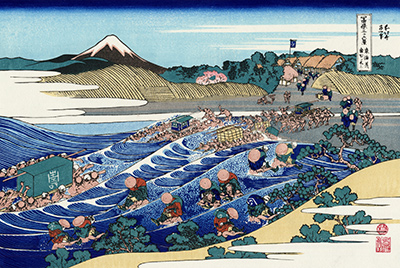Hokusai
The Fuji from Kanaya on the Tokaido by Hokusai
The Fuji from Kanaya on the Tōkaidō or Tōkaidō Kanaya no Fuji, is one of the prints from the famous series of Katsushika Hokusai’s Thirty-six Views of Mount Fuji Fugaku sanjūrokkei.
The print was produced by Hokusai in Japanese Tokyo during the Edo Period. The Edo period is believed to have been between 1615 and 1868. The culture attributed to the Fuji from Kanaya on the Tokaido is a Japanese tradition of believing that the Mount Fuji had the secret of immortality. The dimensions of the painting is 10 1/4 x 15 1/4 in. (26 x 38.7 cm). The medium that was used for the Hokusai’s Fuji from the Kanaya on the Tokaido painting is a Polychrome woodblock print; ink and colour on paper.
In the painting Hukosai depicted travelers crossing the Ōi River at Kanaya on the Tōkaidō highway. He arranges individuals with palanquins in a unique rhythmic style in the swift waves. Hukosai utilizes the monochromatic Mount Fuji to make the colours play in a turbulent manner as they challenge each other with several lines of the Fuji. The painting was published alongside the other Thirty-Six Views of Mount Fuji by a Japanese publisher called Nishimura Yohachi.
The Thirty-Six Views of Mount Fuji was a collection that depicted various sides of the Mount Fuji in different conditions, seasons and from various locations. There were other ten additions to the thirty-six, later on, to make it forty-six in total. Katsushika Hokusai was born in Japan, Tokyo, Edo district on 31st, of 1760 and died on May 1849. He was originally born Tokitaro to a mirror-maker Nakajima Ise who used to paint partially around his mirror’s frames. Even though Hokusai didn’t learn much of the wood block art from his father, he started painting at six-years-old before moving to an apprentice to do wood craving at fourteen years of age. At eighteen years he was accepted at the Katsukawa Shunshō to learn more about the skill that was passionate about his life.
